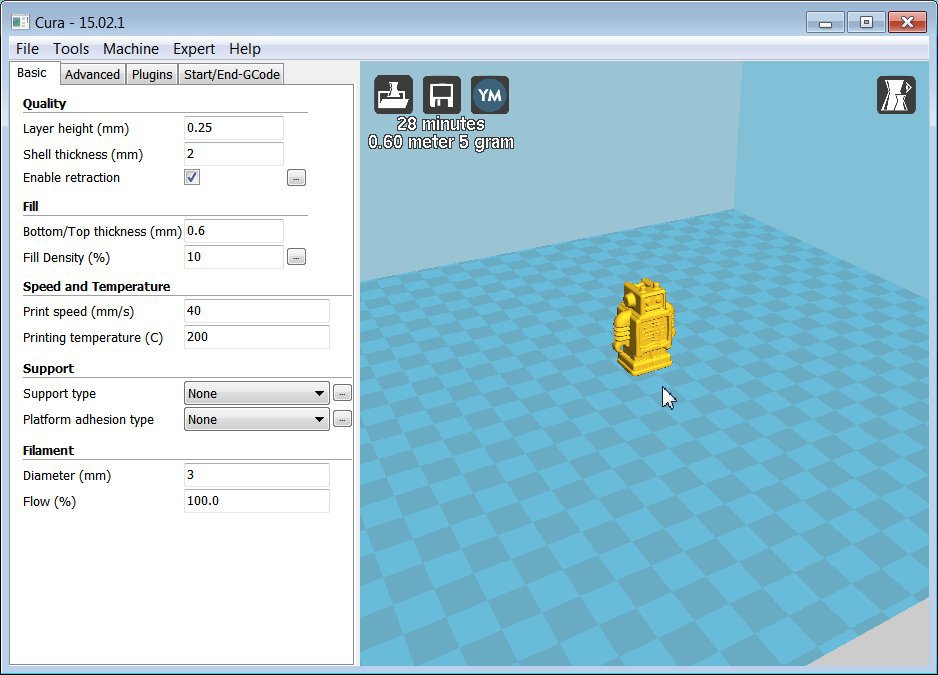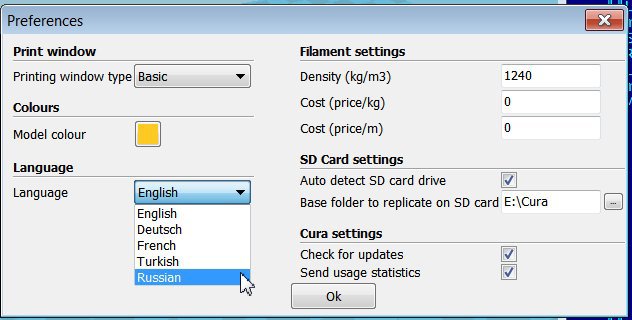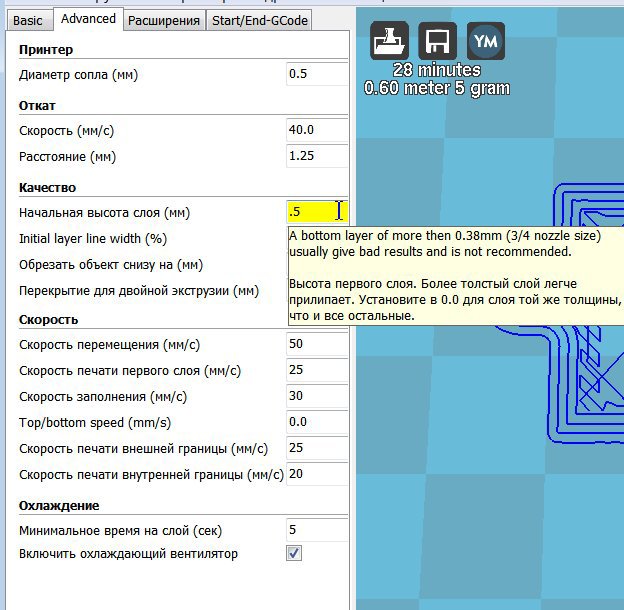The program for 3D-printers Cura 15.02.1
Cura is another free application available for generating G-code for 3D printers.

It can also be used to control a 3D printer via a COM port, but I did not experience this opportunity due to the lack of one of the existing relatively old BFB Rapman printer, which can only print from a USB flash drive.
The first thing we see after the first launch of Cura is the main screen of the application with the main settings:
')

The current version has added support for the Russian language, which, however, is still partial:

In the Russian version, the main screen looks like this:

In the window on the right, you can look at both the 3d model view and the generated trajectory in the “many layers” or “single layer” mode:

At the same time, in the “many layers” mode, for some reason, for the code flavor ( G-code type ) of BFB and Mach3 / LinuxCNC, there is a gap between the blue and green layers. For the rest of the code flavor trajectories in this gap are drawn with a smooth transition from yellow to green, which probably should symbolize the cooling of the layers.
Establishing a simple “top view” for the authors of the program is probably too simple, and therefore, in order to achieve the desired, you need to tinker with the mouse. The keyboard can also be used - use the arrows for rotation, and to move through the layers in the trajectory view mode - the up / down arrows while pressing Shift or Control.
For the BFB and Mach3 / LinuxCNC code flavor, the trajectory is shown as blue lines without thickness, including idle transitions,

For other types of G-code, the color of the trajectories is different for the external / internal walls, filling and idling, and the trajectory itself has a thickness:

However, with a high magnification instead of solid lines, we will see a uniform disgrace:

All settings have pop-up hints, which greatly helps to understand what's what.
It is a little embarrassing that the printing speed is indicated in the basic tab, and the rest speeds - in the advanced tab:

Curious tab "Extensions":

The Tweak extension leads to the appearance of such a trajectory:

And in the real process it will look like this:

As a result, the robot will have an “antenna”. Whether it is possible to use these extensions in real life is not clear, but to turn off these applications back you cannot do anything else but “clear the profile”.
On the last tab (which does not appear for all types of G-code), you can edit the starting and ending section for the G-code of your printer, and which is taken from the corresponding ini-file (see later)

3D printer settings look like this:

The most significant is the type of G-code ( code flavor ), which is proposed to choose from the following options:

What are these options - indicated in the hint:

When you configure a new printer (or when you first install the program), a wizard appears:

If you select the last item, then the following options will be offered:

Option Custom leaves very little chance:

But in other cases, printer profiles are in the \ resources \ machine_profiles folder:

Profiles look at first glance so that it seems that you can configure anything:

Cura allows you to read the following file types:

The presence of gcode in the list of formats is very pleasing, but the joy disappears when viewing layers by layer. There are no some layers at all, some of them have only“horns and legs” idle transitions:

Import of images allows you to get a relief image in which the height corresponds to the brightness:

STL files are read relatively quickly and correctly. However, one of the 35 test files, named, as if on purpose, the sample did not load without issuing any diagnostics.
STL processing occurs “on the fly” - after reading the file and with any change of parameters. For small files, this is not a bad thing, but, for example, turning an object like a skull at a proper angle to the horizon should be slow and sad.
Props are generated automatically, of two kinds. Internal filling is only one option square grid at an angle of 45 degrees to the axes.
Setup for a specific printer BFB pleased neatly decomposed rake.
First, if you select the type of G-code BFB in the file with G-code, instead of the “correct” ends of the lines 0x0D 0x0A, you get 0x0D 0x0D 0x0A:

And the printer controller responds to this in a very peculiar way - everything works, except for the threading, which is set by the M108 command. You can fight this by reading or writing a file in any text editor, but you still had to figure it out.
Secondly, I did not understand how and from where Cura takes the value for the thread feed rate in this command.
If it’s not quite clear to anyone what it is: M108 S400 Set Extruder 1 speed to S value / 10 = 40rpm
As a result, in order to achieve the “nominal feed rate”, the flow rate (Flow%) had to be set to a non-standard value of 4250%. In the normal case, this is “the fluidity of the material, the amount of material being extruded is multiplied by this factor” and usually should be no more than 150. As a result, the length of the fishing line and the weight of the model are considered incorrect.
If you put the turnover in 100%, then for the robot from the example will be considered the weight of 4 grams.
Real weighing showed 3.4

Yes, the "antenna" was bent, it seems from the fact that I did not include the pause at height extension.
Update : the density of the material is set in the “program settings” (well, logically ), and by default there is a density of PLA 1240 kg / m3, and for ABS you need to set 1040, and then the program will estimate the weight of the robot at 3 grams.
Update 2 : It should be added that the C-code does not read the “alien” G-code, and for the BFB of the G-code type, in the trajectory view mode, padding is not shown.

What shows Cura

What happens in reality (in the picture condemned fought).

It can also be used to control a 3D printer via a COM port, but I did not experience this opportunity due to the lack of one of the existing relatively old BFB Rapman printer, which can only print from a USB flash drive.
The first thing we see after the first launch of Cura is the main screen of the application with the main settings:
')

The current version has added support for the Russian language, which, however, is still partial:

In the Russian version, the main screen looks like this:

In the window on the right, you can look at both the 3d model view and the generated trajectory in the “many layers” or “single layer” mode:

At the same time, in the “many layers” mode, for some reason, for the code flavor ( G-code type ) of BFB and Mach3 / LinuxCNC, there is a gap between the blue and green layers. For the rest of the code flavor trajectories in this gap are drawn with a smooth transition from yellow to green, which probably should symbolize the cooling of the layers.
Establishing a simple “top view” for the authors of the program is probably too simple, and therefore, in order to achieve the desired, you need to tinker with the mouse. The keyboard can also be used - use the arrows for rotation, and to move through the layers in the trajectory view mode - the up / down arrows while pressing Shift or Control.
For the BFB and Mach3 / LinuxCNC code flavor, the trajectory is shown as blue lines without thickness, including idle transitions,

For other types of G-code, the color of the trajectories is different for the external / internal walls, filling and idling, and the trajectory itself has a thickness:

However, with a high magnification instead of solid lines, we will see a uniform disgrace:

All settings have pop-up hints, which greatly helps to understand what's what.
It is a little embarrassing that the printing speed is indicated in the basic tab, and the rest speeds - in the advanced tab:

Curious tab "Extensions":

The Tweak extension leads to the appearance of such a trajectory:

And in the real process it will look like this:

As a result, the robot will have an “antenna”. Whether it is possible to use these extensions in real life is not clear, but to turn off these applications back you cannot do anything else but “clear the profile”.
On the last tab (which does not appear for all types of G-code), you can edit the starting and ending section for the G-code of your printer, and which is taken from the corresponding ini-file (see later)

3D printer settings look like this:

The most significant is the type of G-code ( code flavor ), which is proposed to choose from the following options:

What are these options - indicated in the hint:

When you configure a new printer (or when you first install the program), a wizard appears:

If you select the last item, then the following options will be offered:

Option Custom leaves very little chance:

But in other cases, printer profiles are in the \ resources \ machine_profiles folder:

Profiles look at first glance so that it seems that you can configure anything:

Cura allows you to read the following file types:

The presence of gcode in the list of formats is very pleasing, but the joy disappears when viewing layers by layer. There are no some layers at all, some of them have only

Import of images allows you to get a relief image in which the height corresponds to the brightness:

STL files are read relatively quickly and correctly. However, one of the 35 test files, named, as if on purpose, the sample did not load without issuing any diagnostics.
STL processing occurs “on the fly” - after reading the file and with any change of parameters. For small files, this is not a bad thing, but, for example, turning an object like a skull at a proper angle to the horizon should be slow and sad.
Props are generated automatically, of two kinds. Internal filling is only one option square grid at an angle of 45 degrees to the axes.
Setup for a specific printer BFB pleased neatly decomposed rake.
First, if you select the type of G-code BFB in the file with G-code, instead of the “correct” ends of the lines 0x0D 0x0A, you get 0x0D 0x0D 0x0A:

And the printer controller responds to this in a very peculiar way - everything works, except for the threading, which is set by the M108 command. You can fight this by reading or writing a file in any text editor, but you still had to figure it out.
Secondly, I did not understand how and from where Cura takes the value for the thread feed rate in this command.
If it’s not quite clear to anyone what it is: M108 S400 Set Extruder 1 speed to S value / 10 = 40rpm
As a result, in order to achieve the “nominal feed rate”, the flow rate (Flow%) had to be set to a non-standard value of 4250%. In the normal case, this is “the fluidity of the material, the amount of material being extruded is multiplied by this factor” and usually should be no more than 150. As a result, the length of the fishing line and the weight of the model are considered incorrect.
If you put the turnover in 100%, then for the robot from the example will be considered the weight of 4 grams.
Real weighing showed 3.4

Yes, the "antenna" was bent, it seems from the fact that I did not include the pause at height extension.
Update : the density of the material is set in the “program settings” (
Update 2 : It should be added that the C-code does not read the “alien” G-code, and for the BFB of the G-code type, in the trajectory view mode, padding is not shown.

What shows Cura

What happens in reality (in the picture condemned fought).
Source: https://habr.com/ru/post/376721/
All Articles